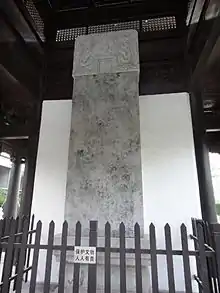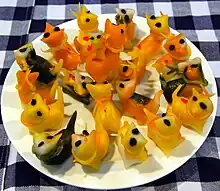Tangxi, Hangzhou
Tangxi,[1] often referred to as Tangqi, is a town located in Linping District of Hangzhou, Zhejiang province, China, 10 kilometers away from the city center of Hangzhou.[2] Tangxi was established a thousand years ago,[3] and it is famous for its loquats and the Prunus mume in the neighboring area of Chaoshan Mountain.
Tangxi
塘栖 | |
|---|---|
塘栖镇 | |
 | |
| Coordinates: 30°47′N 120°18′E | |
| Country | People's Republic of China |
| Province | Zhejiang |
| Sub-provincial city | Hangzhou |
| District | Linping |
| Population | |
| • Total | 90 000 |
| Time zone | UTC+8 (China Standard) |
| Postal code | 311106 |
| Area code | 0571 |
| Tangxi, Hangzhou | |||||||
|---|---|---|---|---|---|---|---|
| Chinese | 塘栖 | ||||||
| |||||||
History
Tangxi was first built in the Northern Song dynasty (960–1127).[2] It used to be a small fishing village. During the Yuan dynasty, Zhang Shicheng broadened the Grand Canal, and local fishermen gradually settled down on both sides. In the Ming dynasty, the Tongji Bridge (通济桥) connected both sides, and the town was enlarged. During the Ming and Qing dynasties, Tangxi ranked the first of top ten famous towns in the Jiangnan region. Originally, Tangxi twas under the administration of Renhe County.
During the Republican era, Tangxi became part of the newly established Hang County. Before 1949, Tangxi consisted of northern and southern towns, with the southern town belonging to Hang County and the northern town belonging to Deqing County. In May 1950, Tangxi ended the separation.[2]
Currently, Tangxi is a town in Linping District of Hangzhou.
Historical sites
Guangji Bridge

Guangji Bridge was built in 1494. At 78.7 meters long, 5.2 meters wide, and 13.86 meters high, it was the only 7-arch stone bridge on the Grand Canal. It is rumoured that the Guangji Bridge was built in the Tang dynasty and expanded in the Ming dynasty. There are 80 steps on each side of the bridge.[4]
Qianlong Stele

The Qianlong Stele was originally located in the branch of Hangzhou Water Conservancy Office in the early Republican era. The office site was destroyed but the stele was reserved because it was embedded into the wall of house of Lu Jinjiang, who was the first executive officer of the Chongyu silk production factory.
The height of the Qianlong Stele is 5.45 meters. The header part is 1 meter high, 1.5 meters wide with the relief of "Two dragons playing a pearl" on it. The main body part is 3.35 meters high, 1.4 meters wide and 0.5 meters thick. The uncovering bottom part is 1.1 meters high 1.8 meters wide, and 0.8 meters thick. The stele was engraved with 429 Chinese characters as the main text and 10 Chinese characters as the signature of the Qianlong Emperor. The written characters served as the regular script. The stele is decorated by carvings of cloerds and dragons.[5]
The main content of the stele describes the Qianlong Emperor rewarding Zhejiang for paying a grain tax during a period of natural disaster when he inspected southern China in 1751. The emperor specially permitted Zhejiang province to reduce the land tax and poll tax by 30 million taels of silver and built the stele to inform the people.
The Qianlong Stele was recognized as a cultural relic under Hangzhou in 2004. The stele and the site of the branch of Hangzhou Water Conservancy Office were then recognized as a cultural relic of Zhejiang province in 2011.[6]
Plum Blossoms in Chaoshan Mountain
Chaoshan Mountain is one of the top three places to view plum blossoms in Jiangnan. The plum blossoms are said to have the distinguishing features of "old, wide and rare".[2][7]
'Old' refers to the fact that Chaoshan Mountain has two of China's five types of ancient plum blossoms: the Tang and Song plum tree.[2]
The Tang Plum Tree is located in front of the fragrance pavilion. It is said to be the incarnation of a fairy named Jiangmei and to be over a thousand years old.[8]
The Song Plum Tree is located in front of the hall of Great Brightness. The body of the original plum tree withered to a large extent, but did continue to bloom for a number of years. However, it has since died.[8]
'Wide' refers to how Chaoshan Mountain had a wide swath of plum blossoms which extended for miles. Nowadays, there are still thousands of plum-blossom trees, and a variety of breeds, including scarlet, pink, red, and green.[2] Some sources allege that "Plum fragrance can be felt within 10 miles" and that "Chaoshan plum blossoms are second to none".[8]
The Chaoshan plum-blossoms are regarded as 'rare' because they have six petals, rather than five.
Cuisine
Cì máo ròuyuán (刺毛肉圆) is considered one of the most famous foods from Tangxi. It consists of meatballs and glutinous rice. It is said that this dish was invented by a local chief when the Qianlong Emperor once travelled down south from Beijing via the Grand Canal.[9]
Xìshā yáng wěi (细沙羊尾) is a dessert consisting of fried dough with red bean paste inside. It is named after its shape, which looks similar to a sheep's tail (yáng wěi 羊尾).[10]
Tradition
It is believed that eating a Lìxià Dog (立夏狗) made of 80% glutinous rice and 20% rice vermicelli during Lixia could protect children from chronic summer fever.[11]

Notable residents
- Wu Changshuo (1844–1927)
- Wu was said to be very fond of the plum blossoms on Chaoshan Mountain.[2]
- Feng Zikai[12]
References
- "余杭区地名办提供最权威说法应该念成塘xī 尊重当地大部分人的读音·都市快报" [Yuhang District Geographical Naming Office provides the most authoritative source saying that it should be pronounced as Tángxī, respecting the pronunciation of most local people]. Hangzhou Daily (in Chinese). February 7, 2012. Retrieved June 24, 2020.
- "Tangqi Ancient Town". Tangqi GOV. Archived from the original on 12 July 2007. Retrieved 19 May 2013.
- "Tangqi town to opens to tourists as of National Day". chinabaike.com. Retrieved 14 May 2013.
- "广济桥". tangqi.org.cn. Archived from the original on 2 May 2014. Retrieved 14 May 2013.
- "The Grand Canal Hangzhou". en.grandcanal.com.cn. Retrieved 14 May 2013.
- "运河瑰宝——塘栖干隆御碑". 林金木. Retrieved 14 May 2013.
- "Palm blossom at Chaoshan". en.wl-expo.com. Archived from the original on 19 April 2014. Retrieved 14 May 2013.
- "The Chaoshan Scenic Area". cstour.cn. Archived from the original on 24 December 2013. Retrieved 14 May 2013.
- "刺 毛 肉 圆". Tangqi Gvo. Retrieved 14 May 2013.
- "细沙羊尾". Tangqi Gvo. Retrieved 14 May 2013.
- "Tradition of Tangqi – Lixia Dog". 三点一四一屋酒. 2007-05-17.
- "[名人剪影]悠闲诗意 丰子恺在塘栖". 新华网浙江频道. 2009-05-30. Archived from the original on 2 May 2014. Retrieved 14 May 2013.